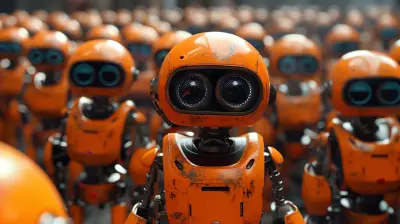How to Implement Machine Learning Algorithms in Python
12 October 2025
Ever wondered what it’s like to teach your computer how to think? Sounds wild, right?
Well, that’s machine learning for you.
It’s not just a buzzword tossed around in tech circles anymore — it's the engine under the hood of everything from Netflix recommendations to spam filters and even self-driving cars. And guess what? You don’t need to be a Silicon Valley genius to dive in. With Python as your sidekick, implementing machine learning algorithms becomes less of a rocket science and more of an intriguing journey.
So, grab your favorite cup of coffee — because we’re going for a deep (yet totally digestible) dive into how to implement machine learning algorithms in Python.
🎯 Why Python for Machine Learning? Because It Just Makes Sense
Python is like that friend who just gets it. Simple, intuitive, yet incredibly powerful. Unlike some programming languages that have a steep learning curve, Python speaks a language that's closer to English. It’s beginner-friendly and still robust enough for heavy-duty machine learning operations.Not convinced? Let’s break it down:
- Readable syntax — Clean code you can actually read a month later.
- Massive libraries — Think of Python libraries as pre-built Lego blocks: you can snap them together to create cool models without starting from scratch.
- Huge community — Stuck somewhere? Someone else probably hit the wall before you and found a way around it.
With that, let's roll up our sleeves and get into the nuts and bolts.
🧰 Step 1: Setting Up Your Playground
Before we start building models, we need the right tools. Think of this step as sharpening your pencils before sketching a masterpiece.🔧 Install Python and Jupyter Notebook
First things first, you’ll need Python installed. The easiest way? Download Anaconda. It comes bundled with Python and Jupyter Notebook — a perfect combo for coding and visualizing in real-time.bash

Alternatively, use pip if you're not into Anaconda
pip install notebook
Fire up your notebook:
bash
jupyter notebook
📦 Install Essential Libraries
Here’s your starter pack — the Avengers of machine learning in Python:bash
pip install numpy pandas matplotlib seaborn scikit-learn
- `numpy` & `pandas`: Data manipulation ninjas
- `matplotlib` & `seaborn`: Plotting heroes
- `scikit-learn`: The actual brains behind most ML algorithms
🧠 Step 2: Understanding the Machine Learning Lifecycle
Before we shoot arrows in the dark, let’s light the path. Machine learning isn’t just about throwing data at an algorithm and hoping for magic. There’s a method to the madness.The Typical ML Flow Looks Like This:
1. Define the problem: What are we solving?2. Prepare the data: Cleaning, tweaking, and transforming.
3. Choose the algorithm: Pick your model — like picking a game character.
4. Train the model: Feed it data and teach it.
5. Test the model: See how well it learned.
6. Tune and optimize: Adjust parameters to make it smarter.
7. Deploy and monitor: Set it free in the real world.
Now let’s break down these steps with some hands-on Python examples, shall we?
📊 Step 3: Load and Explore Your Data
Let’s say we’re solving a classic supervised learning problem — predicting whether someone will buy a product based on their age and income.Here’s some mock data in a CSV file named `customers.csv`. Let’s load it up!
python
import pandas as pddata = pd.read_csv('customers.csv')
print(data.head())
🧹 Clean Your Data
Our data might have missing values or weird outliers. Time to tidy it up.python
Fill missing values
data = data.fillna(data.mean())Convert categorical variables
data = pd.get_dummies(data, drop_first=True)
⚙️ Step 4: Choose and Implement Your ML Algorithm
Here’s the fun part — the juicy core. Let’s start with a Supervised Learning algorithm.🧪 Example: Logistic Regression (Binary Classification)
Let’s predict whether the customer made a purchase (1 or 0).python
from sklearn.model_selection import train_test_split
from sklearn.linear_model import LogisticRegression
from sklearn.metrics import accuracy_scoreFeatures and labels
X = data[['Age', 'Annual_Income']]
y = data['Purchased']
Split the data
X_train, X_test, y_train, y_test = train_test_split(X, y, test_size=0.2, random_state=0)Train the model
model = LogisticRegression()
model.fit(X_train, y_train)
Predict
y_pred = model.predict(X_test)Evaluate
print("Accuracy:", accuracy_score(y_test, y_pred))
Boom. Your first machine learning model just predicted the future.
🔄 Step 5: Try Different Algorithms (Because Why Stop at One?)
Each algorithm has its own flair. Like different kinds of artists — some paint landscapes, others abstract.Let’s test a few more.
🎯 Decision Tree Classifier
Intuitive, easy to visualize, and no need to normalize data.python
from sklearn.tree import DecisionTreeClassifiertree_model = DecisionTreeClassifier()
tree_model.fit(X_train, y_train)
tree_pred = tree_model.predict(X_test)
print("Tree Accuracy:", accuracy_score(y_test, tree_pred))
📈 Support Vector Machines (SVM)
Great for high-dimensional data.python
from sklearn.svm import SVCsvm_model = SVC()
svm_model.fit(X_train, y_train)
svm_pred = svm_model.predict(X_test)
print("SVM Accuracy:", accuracy_score(y_test, svm_pred))
🧠 Random Forest (An Ensemble Model)
Like consulting a group of experts instead of just one.python
from sklearn.ensemble import RandomForestClassifierforest_model = RandomForestClassifier(n_estimators=100)
forest_model.fit(X_train, y_train)
forest_pred = forest_model.predict(X_test)
print("Random Forest Accuracy:", accuracy_score(y_test, forest_pred))
🌿 Step 6: Tune Your Models (Give It Some Fertilizer)
No model is perfect out of the box. Hyperparameter tuning is your secret sauce.Use GridSearch to Optimize
python
from sklearn.model_selection import GridSearchCVparam_grid = {'n_estimators': [50, 100, 150], 'max_depth': [None, 10, 20]}
grid = GridSearchCV(RandomForestClassifier(), param_grid, cv=5)
grid.fit(X_train, y_train)
print("Best Params:", grid.best_params_)
print("Best Score:", grid.best_score_)
This is like trying different settings in a video game until you find the cheat code.
📈 Step 7: Visualize for Better Understanding
Data is beautiful when you stare at it long enough. Let’s see our results.python
import seaborn as sns
import matplotlib.pyplot as plt
from sklearn.metrics import confusion_matrixcm = confusion_matrix(y_test, y_pred)
sns.heatmap(cm, annot=True, cmap="Blues")
plt.xlabel('Predicted')
plt.ylabel('Actual')
plt.title('Confusion Matrix')
plt.show()
Visuals tell stories numbers can’t.
📦 Step 8: Save and Deploy Your Model
Once your model is trained and tested, it’s time to make it useful — save it and use it elsewhere.python
import joblib
Save the model
joblib.dump(model, 'logistic_model.pkl')Load it again when needed
loaded_model = joblib.load('logistic_model.pkl')
You’ve just built an intelligent system. Let that sink in.
🛣️ What's Next? The Path Ahead
First of all, give yourself a pat on the back.You’ve taken your first major steps into the world of machine learning. But this is just the beginning. There’s so much more to explore:
- Dive into deep learning with TensorFlow or PyTorch.
- Work on unsupervised learning like clustering.
- Tackle real-world datasets — Kaggle is a great playground.
- Experiment with natural language processing, computer vision, and reinforcement learning.
The world is your dataset.
🧡 Wrapping It All Up
Implementing machine learning algorithms in Python isn’t as intimidating as it sounds. With the right mindset (and this guide), you can go from data novice to ML pro — one algorithm at a time.Whether it's classifying emails, predicting trends, or building your own intelligent app, the skills you’re learning here are changing the world — one line of code at a time.
Just remember: start small, stay curious, and always keep testing.
Who knows? Maybe the next breakthrough in AI will come from your keyboard.
all images in this post were generated using AI tools
Category:
Coding LanguagesAuthor:

Pierre McCord
Discussion
rate this article
1 comments
Daria Pope
Great article! Your clear explanations and step-by-step guidance make implementing machine learning algorithms in Python accessible for everyone. It's inspiring to see how you break down complex concepts into manageable parts. I can’t wait to try out these techniques in my own projects. Keep up the fantastic work!
October 14, 2025 at 4:55 AM

Pierre McCord
Thank you so much for your kind words! I'm glad you found the article helpful and inspiring. Good luck with your projects!


